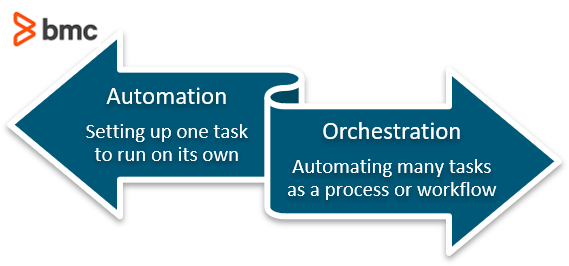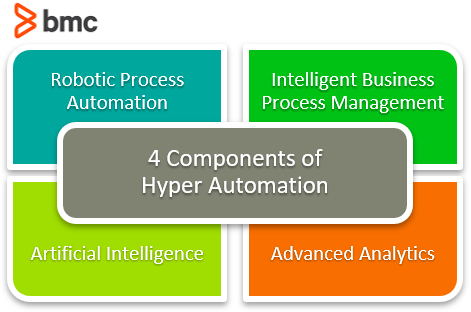IT automation is an important feature of any successful business, especially one that’s undergoing digital transformation. Orchestrating IT automation leads to greater efficiency and can lend itself to a hyper automation business model where automation exists in every part of the business.
If you’re considering IT automation, let this article be your guide. Here we will:
- Define IT automation
- Look at beginner use cases
- Explore the benefits
- Share tips for getting started
So, stay tuned for everything you need to know about IT automation!
What is IT automation?
IT automation is the process that sets rules for IT tasks so that they can be completed, automatically or upon trigger, by a machine.
Automation leaves humans people to work in areas of IT where their efforts are better spent, like strategizing or developing (and not on rote tasks like password resets). In practice, IT automation replaces manual tasks with automatic ones in important areas like:
- Data centers
- Cloud deployments
- Service desk
- Development
When it comes to automating IT tasks, there is a broad scope to consider. Automation could be as minimal as automating individual one-off tasks or as intensive as automatic full deployments. IT automation and orchestration are related but different:
- IT automation implies making a routine task automatically repeatable.
- Orchestration is the process of doing this across an entire process or practice so that operations, as a whole, are performed better and more securely.

(Go deeper into the automation vs orchestration comparison.)
How to apply IT automation in your business
There are several uses for IT automation. In your digital enterprise, count on automating the following areas for greater efficiency in your organization:
Cloud processes
With businesses running multi-cloud and hybrid cloud environments, it’s never been more important to automate routine cloud processes. By including IT automation in your cloud operations, you get closer to full orchestration and, ultimately, running at peak effectiveness.
To get started with cloud automation, single-out individual and clusters of cloud processes to automate. These clouds might not be your most important ones yet. Start small, and as you build on success, you can expand to automating more vital clouds.
The help/service desk
The service desk is one area that every company has (or should have!) that is ripe for automation. There are plenty of areas where uncomplicated task automation can have an immediate impact, as ITSM expert Kirstie Magowan points out:

(See tips for beginning to automate the service desk.)
DevOps & software development
Automation is a key principle of DevOps. Without automation in your software development practice, you likely aren’t fully embracing DevOps. DevOps automation can apply across the software development lifecycle (SDLC), especially in:
- Deployment automation (CI/CD)
- Test automation
- Monitoring
- Log management
(Explore the close roles of automation and DevOps practices.)
Business processes
Automating business processes is something Gartner defines as:
The automation of complex business processes and functions beyond conventional data manipulation and record-keeping activities, usually through the use of advanced technologies.
Enhancements to process automation are currently being led by these cognitive technologies, including:
The business process automation (BPA) market is estimated to be worth $232 billion USD by the year 2025.
Configuration
Configuration is one of those necessary functions when you run a digital business. With multiple cloud services, servers, networks, and environments, there is no shortage of things to configure. By automating configuration, you can:
- Ensure environments are configured correctly
- Reducing errors
- Increase overall productivity
Resource provisioning
When working within a digital business, provisioning resources is essential. This refers to sharing and allocating space and user access to servers, programs and cloud processes required to do your job effectively. And it’s a great place to automate.
(Learn more about infrastructure automation platforms.)
Monitoring & response
Security process automation, like monitoring and response, can help IT professionals offload routine security processes so they can focus on things like bug fixes, testing and infrastructure issues.
Benefits of IT Automation
There are many benefits of automation. Here some of the ones we believe are the most critical to digital businesses:
Save money & resources
When productivity is at peak efficiency, digital enterprises save money.
Not only that, but labor spending is also reduced and workers spend time and resources working on more important, value-added tasks. The result can be significant cost savings.
Increase speed and efficiency
While cost goes down with IT automation, operational efficiency increases. Development gets faster when time-consuming tasks like configuration are taken from developers and implemented automatically,instead. This also results in:
- Consistent environments
- More refined testing
- Better overall products and services
Enhance security
Automation helps businesses enhance their security. By removing time-consuming and effort-filled tasks like monitoring from the developer’s responsibilities through automation, developers and other cybersecurity professionals can focus proactively on preventing vulnerabilities and threats from becoming larger problems.
Create fewer errors
When you automate IT processes, you reduce the chance for human error. As a result, fewer errors occur and an error-free business is more efficient and better at servicing customers. With less chance for human error, your business can focus on what you do best—not on resolving issues.
Achieve orchestration & hyper automation
Orchestration and hyper automation are important goals for digital businesses to strive to achieve as they continue their digital evolution. The most successful and competitive digital businesses will automate and orchestrate as many tasks and processes as possible to ensure the best use of resources, service delivery and customer satisfaction.
(Become a hyper automated business.)

IT automation best practices
Here are some tips that developers can use when deploying IT automation:
- Carefully consider what to automate. You can’t automate everything. While it may be exciting to try, you should determine in advance what processes to automate and how to use the human expertise that you have freed up as a resource.
- Identify work that takes the lowest-skill and the most time. These are the first processes that you should automate.
- Seek out team buy-in. Before making big changes to the automation of the IT infrastructure, talk to the IT team and get their ideas and approval. This makes the transition process go more smoothly.
- Prioritize flexibility. One criticism of automation is its lack of flexibility due to its adherence to rules. If you want to get the most out of IT automation, prioritize flexibility in your IT enterprise.
- Make a plan for long-term goals. Think about what infrastructure automation makes sense as an end-to-end solution for long-term growth, and prioritize those tasks.
- Designate lead automation specialist. Designating someone as your automation lead gives businesses a point of contact to funnel resources to and from in the name automating.
- Use documentation. Documentation of automation should be created each time a process is automated.
- Say no sometimes. It’s encouraged that you decline automation projects when they don’t fit within your infrastructure design and processes. Being discerning with automation is important to overall success.
The future of IT automation
IT automation will continue to be useful for companies that want to evolve as a digital enterprise. In today’s business economy, companies have only begun to realize the benefits of machine learning. Automation of critical infrastructure will expand as knowledge of machine learning applications in business does.
In addition to more inventive business uses for machine learning, there’s also the continued evolution of scripting tools that will change how automation is used in IT. Finally, automation creates opportunities to discover new metrics that offer insights about your company’s performance.







